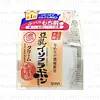What's inside
What's inside
 Key Ingredients
Key Ingredients

No key ingredients
 Benefits
Benefits

 Concerns
Concerns

 Ingredients Side-by-side
Ingredients Side-by-side

Water
Skin ConditioningGlycerin
HumectantButylene Glycol
HumectantDipropylene Glycol
HumectantHydrogenated Polyisobutene
EmollientAlcohol Denat.
AntimicrobialHydrogenated Castor Oil Hydroxystearate
Skin ConditioningTriethylhexanoin
MaskingHydrogenated Lecithin
EmulsifyingDimethicone
EmollientAstaxanthin
Skin ConditioningRosa Canina Fruit Oil
EmollientGlycosyl Trehalose
Emulsion StabilisingSuccinoyl Atelocollagen
Skin ConditioningPunica Granatum Extract
AstringentHydrogenated Starch Hydrolysate
HumectantSodium Hydroxide
BufferingEthylparaben
PreservativePhenoxyethanol
PreservativeMethylparaben
PreservativeParfum
MaskingCaramel
Cosmetic ColorantWater, Glycerin, Butylene Glycol, Dipropylene Glycol, Hydrogenated Polyisobutene, Alcohol Denat., Hydrogenated Castor Oil Hydroxystearate, Triethylhexanoin, Hydrogenated Lecithin, Dimethicone, Astaxanthin, Rosa Canina Fruit Oil, Glycosyl Trehalose, Succinoyl Atelocollagen, Punica Granatum Extract, Hydrogenated Starch Hydrolysate, Sodium Hydroxide, Ethylparaben, Phenoxyethanol, Methylparaben, Parfum, Caramel
Water
Skin ConditioningSqualane
EmollientStearic Acid
CleansingStearyl Alcohol
EmollientGlycine Max Seed Extract
Skin ConditioningButylene Glycol
HumectantTocopheryl Acetate
AntioxidantXanthan Gum
EmulsifyingMilk Ferment
Skin ConditioningCarbomer
Emulsion StabilisingSodium Hydroxide
BufferingAlcohol Denat.
AntimicrobialPalmitic Acid
EmollientCetearyl Alcohol
EmollientAluminum Starch Octenylsuccinate
AbsorbentGlycerin
HumectantCitric Acid
BufferingCyclohexasiloxane
EmollientBeeswax
Emulsion StabilisingMethylparaben
PreservativeGlyceryl Stearate
EmollientCyclopentasiloxane
EmollientWater, Squalane, Stearic Acid, Stearyl Alcohol, Glycine Max Seed Extract, Butylene Glycol, Tocopheryl Acetate, Xanthan Gum, Milk Ferment, Carbomer, Sodium Hydroxide, Alcohol Denat., Palmitic Acid, Cetearyl Alcohol, Aluminum Starch Octenylsuccinate, Glycerin, Citric Acid, Cyclohexasiloxane, Beeswax, Methylparaben, Glyceryl Stearate, Cyclopentasiloxane
Ingredients Explained
These ingredients are found in both products.
Ingredients higher up in an ingredient list are typically present in a larger amount.
Alcohol Denat. is an alcohol with a denaturant property. It is created by mixing ethanol with other additives.
This ingredient gets a bad rep because it is irritating and drying - mostly due to its astringent property. Astringents draw out natural oils in tissue, constricting pores and leaving your skin dried out.
However, alcohol denat. is not all that bad.
Due to its low molecular weight, alcohol denat. tends to evaporate quickly. One study on pig skin found half of applied alcohol evaporated in 10 seconds and less than 3% stayed on skin.
This also helps other ingredients become better absorbed upon application.
Studies are conflicted about whether this ingredient causes skin dehydration. One study from 2005 found adding emollients to propanol-based sanitizer decreased skin dryness and irritation. Another study found irritation only occurs if your skin is already damaged.
Small amounts of alcohol are generally tolerated by oily skin or people who live in humid environments.
The rule of thumb is if this alcohol is near the end of an ingredients list, it will probably not affect your skin much.
Also...
This ingredient has antimicrobial and solvent properties.
The antimicrobial property helps preserve products and increase their shelf life. As a solvent, it helps dissolve other ingredients.
Other types of astringent alcohols include:
Learn more about Alcohol Denat.Butylene Glycol (or BG) is used within cosmetic products for a few different reasons:
Overall, Butylene Glycol is a safe and well-rounded ingredient that works well with other ingredients.
Though this ingredient works well with most skin types, some people with sensitive skin may experience a reaction such as allergic rashes, closed comedones, or itchiness.
Learn more about Butylene GlycolGlycerin is already naturally found in your skin. It helps moisturize and protect your skin.
A study from 2016 found glycerin to be more effective as a humectant than AHAs and hyaluronic acid.
As a humectant, it helps the skin stay hydrated by pulling moisture to your skin. The low molecular weight of glycerin allows it to pull moisture into the deeper layers of your skin.
Hydrated skin improves your skin barrier; Your skin barrier helps protect against irritants and bacteria.
Glycerin has also been found to have antimicrobial and antiviral properties. Due to these properties, glycerin is often used in wound and burn treatments.
In cosmetics, glycerin is usually derived from plants such as soybean or palm. However, it can also be sourced from animals, such as tallow or animal fat.
This ingredient is organic, colorless, odorless, and non-toxic.
Glycerin is the name for this ingredient in American English. British English uses Glycerol/Glycerine.
Learn more about GlycerinMethylparaben is a preservative and is a paraben. It is used to prevent the growth of fungus, mold, and other harmful bacteria. Parabens are chemicals used as preservatives in both cosmetics and food.
Methylparaben can be synthetically created. It can also be found naturally in some fruits, such as blueberries.
Oftentimes, Methylparaben is combined with other parabens to help increase the shelf life.
The safety of Methylparaben is currently being studied. While ongoing studies are looking into the safety of parabens, the results have been very mixed. Some studies have not found Methylparaben to be harmful.
Learn more about MethylparabenSodium Hydroxide is also known as lye or caustic soda. It is used to adjust the pH of products; many ingredients require a specific pH to be effective.
In small amounts, sodium hydroxide is considered safe to use. However, large amounts may cause chemical burns due to its high alkaline.
Your skin has a natural pH and acid mantle. This acid mantle helps prevent harmful bacteria from breaking through. The acid mantle also helps keep your skin hydrated.
"Alkaline" refers to a high pH level. A low pH level would be considered acidic.
Learn more about Sodium HydroxideWater. It's the most common cosmetic ingredient of all. You'll usually see it at the top of ingredient lists, meaning that it makes up the largest part of the product.
So why is it so popular? Water most often acts as a solvent - this means that it helps dissolve other ingredients into the formulation.
You'll also recognize water as that liquid we all need to stay alive. If you see this, drink a glass of water. Stay hydrated!
Learn more about Water